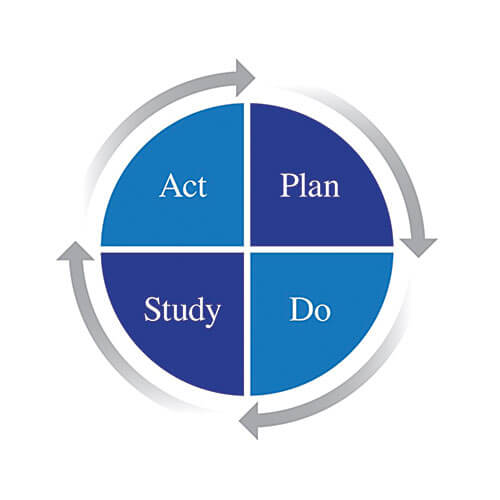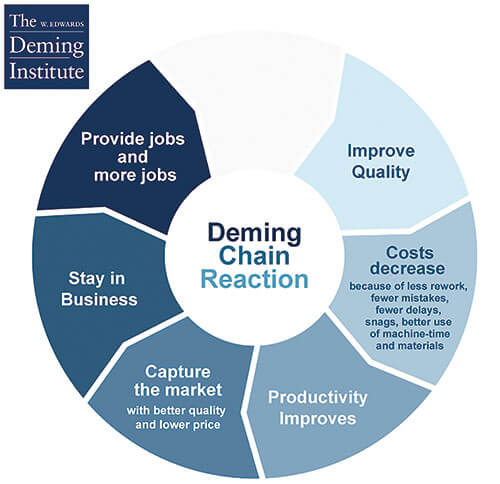IEHA and The W. Edwards Deming Institute
Welcome to the first installment of the IEHA-Deming Institute Success Series—a collaboration between IEHA, a division of ISSA founded in 1930, and The W. Edwards Deming Institute®, founded in 1993 to carry on the work of W. Edwards Deming.
The series provides IEHA members with tools for success through the application of the Deming System of Profound Knowledge® (SoPK), established by Dr. Deming to extend his teachings to all business types, including those in both the manufacturing and service sectors.
The success formula
Dr. Deming believed success in any job is finding joy in work through excellence, continual improvement, teamwork, and fiscal wisdom in a systematic approach. His concept is epitomized by a “we” not “me” philosophy.
Deming’s time-tested methods helped the Japanese firm Toyota rise from the ashes of World War II to become one of the most successful companies in history.
These methods can help IEHA members rise to unprecedented heights as well.
Shared project—Integrated Cleaning and Measurement (ICM)
Since The Deming Institute served as a content reviewer and co-developer of the three new ICM Modules produced in 2019 as part of the Continual Improvement section of IEHA’s Professional Education Credentialing Program (PECP) curriculum, our series will begin with a discussion of how ICM can help IEHA members succeed through the Deming lens.
What is ICM?
Integrated Cleaning and Measurement (ICM) is a system for successfully managing, measuring, and enhancing the cleaning process and outcome.
A key to success within ICM is the development of a specific aim. Dr. Deming said: “A system is a network of interdependent components that work together to try to accomplish the aim of the system. A system must have an aim. Without an aim, there is no system.”
Broadly, ICM aims to manage and improve the process and outcome of commercial cleaning with input from stakeholders. ICM sets goals by facility type and based on dialog with senior leadership, facility directors, environmental services/custodial teams, and customers.
ICM’s objectives may include:
- Providing continually improving healthful outcomes for people.
- Providing continually improving beneficial results for business.
- Cultivating continually improving respect, meaning, and relevance for workers in facility services.
Contextual excellence
ICM’s aims are further qualified to achieve “contextual excellence” within a given facility, that is, excellence within the context of how areas within the same facility are used.
For example, in healthcare facilities, reducing hospital-acquired infection (HAI) is a priority, but the most stringent ICM-related improvements for contextual excellence in organic soil removal would be in operating suites, with less demanding goals in waiting rooms.
In hotels, room aesthetics and improving room turnaround may take precedence. However, since hotel worker injuries are highest among housekeepers, ICM’s hotel contextual excellence goal may relate to improving room turnaround time while reducing the number of housekeeper injuries.
Why is measurement a main component of ICM?
Professionals measure to assess conditions, make, and track improvements. That is true of every recognized discipline from medicine to engineering. It should be true of the cleaning sector.
The professionalism of the cleaning industry with resulting positive impacts on value-creation, business outcomes, and pay scales can best be achieved via measurement of specific outcomes with practical considerations in mind.
The path to continuous improvement: PDSA
Dr. Deming established the Plan, Do, Study, Act (PDSA) Cycle to create a progressive, systematic, and stepped path to perpetual excellence. IEHA, in turn, developed the Continual Stepped Improvement™ (CSI) framework based on PDSA.
Here is an example of how PDSA could be applied to a dusty office situation:
Plan: Identify and reduce/eliminate apparent sources of dust within Building A but not found in other buildings (e.g., three high-speed laser printers in Bldg. A vs. low-speed ink-jet printers elsewhere; 10 boxes of facial tissue* on desks throughout Building A vs. three to five in other buildings; workers are using feather dusters in Building A vs. microfiber dusters in other buildings).
These sources are identified as likely culprits through the use of particle counters showing airborne dust spikes near these suspected sources.
Removing added dust sources should help eliminate the cause of overly dusty desks.
Do: Sequester laser printers to a utility room with exhaust ventilation; reduce boxes of facial tissue in office spaces to five; replace feather dusters with microfiber dusters. Do a 60-day test and measure the (actual) dust results in both airborne and resettled dust.
Study: Actual results show a significant lowering of airborne dust and dust buildup as shown by both desktop particle counters and anecdotal white-glove assessment respectively. Dust accumulation levels are still slightly elevated in Building A compared to others.
Act: Since dust levels were reduced by the changes, keep them. Restart the PDSA cycle by finding and managing possible additional dust sources, such as leaky weather seals at exterior windows, variances in HVAC system operations between building A and others, etc. Run each as a separate PDSA seeking to make CSIs to processes affecting cleaning outcomes.
Importantly, PDSA and CSI affect the bottom line and produce a strong Return on Investment (ROI).
Return on Investment
Through the Deming lens, Return on Investment (ROI) comes from:
- Focusing on the causes of cost
- Simplifying and enhancing processes
- Less waste
- Fewer errors
- Costs going down as quality goes up
- Improving productivity and effectiveness.
Per a 2008 University of Heidelberg thesis paper, The application of business excellence models…interpreted by the values and priorities of W. Edwards Deming:
“The Deming chain reaction lets you reward workers as the company prospers, instead of seeking to prosper on the backs of workers.”
“Investing in excellence as a core of business strategy pays…through increased sales, through reduced costs and process efficiency…”
The paper noted that companies committed to business excellence showed an increase of 18% in operating income and 40% in total assets.
We’ll discuss more about ROI from the IEHA-Deming Way in a future article.
Questions?
Stay tuned for the IEHA SMART Podcast series in Spring 2020 designed to answer your questions and help you advance on the path to success.
In 2020, IEHA will survey its members using Dr. Deming’s survey methodology to determine more ways to grow by addressing specific IEHA member challenges.
Please stay tuned!
*Each time a tissue is pulled from its box, a micro-dust cloud is created. Moving these to lounge and restroom areas having exhaust ventilation should lower airborne and resettling dust.



















